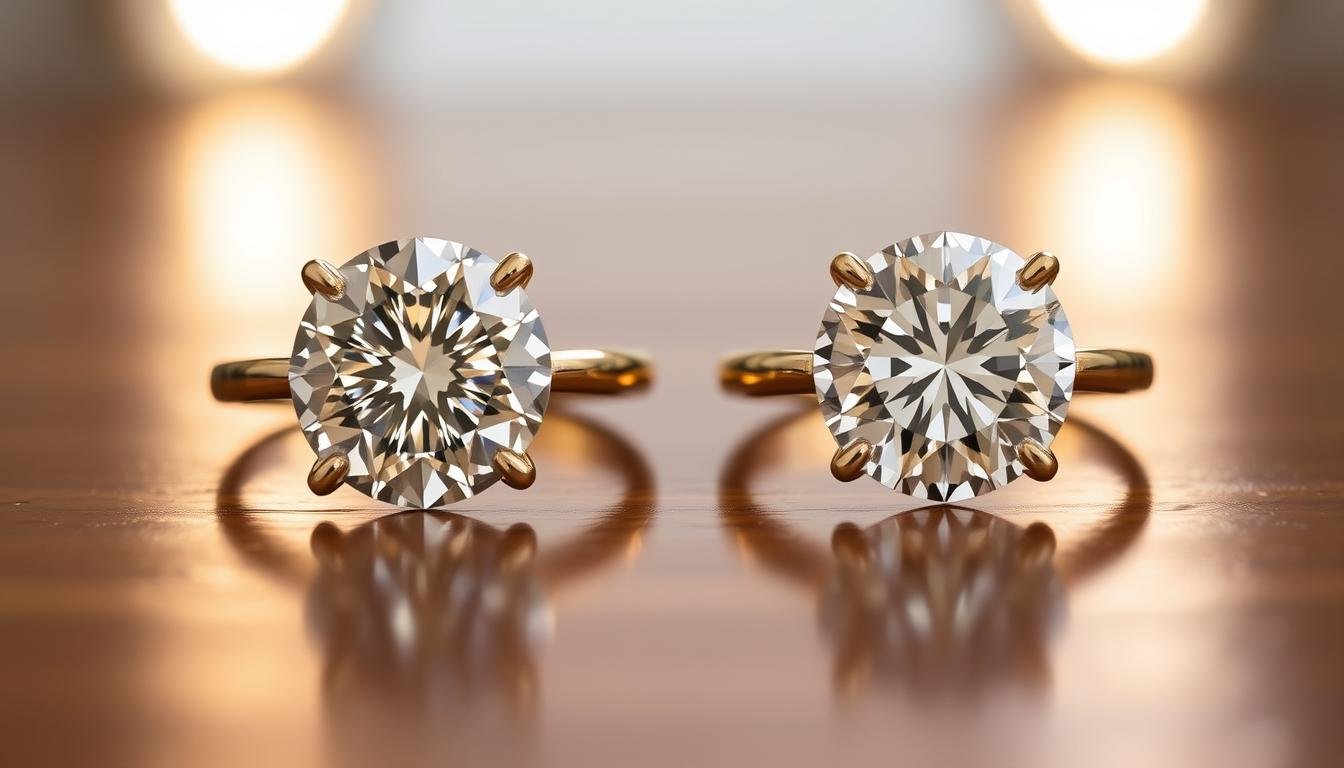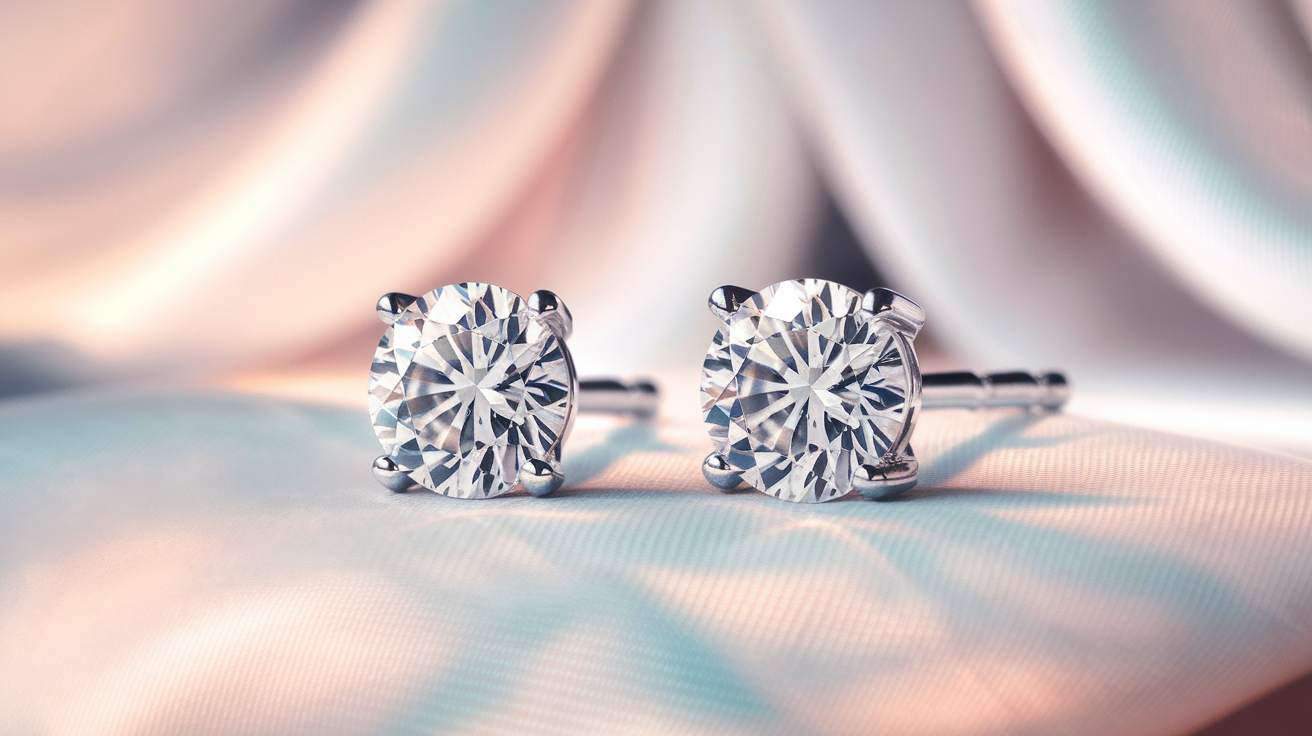Choosing between natural and lab-created diamonds for diamond rings is a big decision. This guide helps you understand the differences between these two options. It’s all about finding the right diamond that fits your style and values.
The natural vs. lab created diamond rings debate is growing. New technology makes lab-grown diamonds a cost-effective choice. This guide covers everything from how they’re made to their environmental impact. It’s here to help you choose with confidence.
Key Takeaways
- Learn the main differences between natural and lab-created diamonds.
- Find out about the price and value of both types of diamonds.
- Discover how diamonds affect the environment and ethics.
- Know how to check if your diamond is real and of good quality.
- See how natural and lab-created diamonds look different.
Whether you want a natural diamond’s timeless beauty or a lab-created diamond’s modern sparkle, this guide is for you. It helps you make a choice that reflects your taste and values. Explore the world of diamonds and find the perfect ring for your special moments.
Understanding Diamond Origins: Natural vs. Lab Created
Diamonds start their journey deep in the Earth’s mantle. Here, intense heat and pressure shape them over billions of years. On the other hand, lab-grown diamonds are made using technology. They have the same qualities as natural diamonds.
Formation Process of Natural Diamonds
Natural diamonds form in extreme conditions. They need temperatures over 1,000°C (1,832°F) and pressures 45,000 times Earth’s atmosphere. This process takes 1 to 3.3 billion years, as carbon atoms turn into diamonds deep in the Earth.
Technology Behind Lab-Grown Diamonds
Lab-grown diamonds are made using advanced technology. They use High-Pressure High-Temperature (HPHT) and Chemical Vapor Deposition (CVD) methods. These methods control temperature, pressure, and carbon to grow diamonds in weeks or months.
Key Differences in Creation Methods
- Natural diamonds take billions of years to form, while lab-grown diamonds are made in weeks or months.
- Natural diamonds form in the Earth’s mantle’s intense heat and pressure. Lab-grown diamonds are made in controlled labs.
- Natural diamonds form slowly through geological processes. Lab-grown diamonds are made quickly with technology.
Knowing how mined and lab-grown diamonds are made helps us understand their unique qualities and origins.
Physical and Chemical Properties Comparison
Understanding diamond quality and certification is key. Natural diamonds form deep in the Earth over billions of years. Lab-created diamonds are made in a controlled setting with advanced tech.
Natural and lab-created diamonds look similar but have slight differences. They both have carbon atoms in a crystalline structure. This makes them hard, durable, and shiny. But, diamond certification can spot these tiny differences.
| Property | Natural Diamond | Lab-Created Diamond |
|---|---|---|
| Chemical Composition | Pure carbon | Pure carbon |
| Crystalline Structure | Cubic | Cubic |
| Hardness | 10 on the Mohs scale | 10 on the Mohs scale |
| Refractive Index | 2.42 | 2.42 |
| Dispersion | 0.044 | 0.044 |
Natural and lab-created diamonds have almost the same physical properties. But, their chemical and structural differences can be found with advanced tests. This is important for checking the diamond’s quality and if it’s real or not.
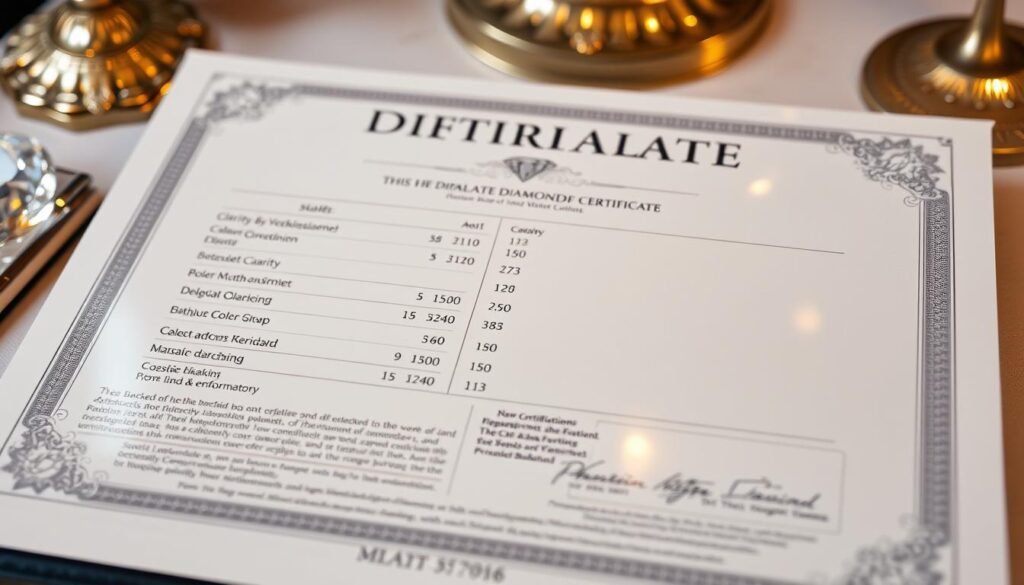
“The ability to accurately identify and distinguish natural diamonds from lab-created ones is essential for maintaining the integrity of the diamond industry.”
Natural vs. Lab Created Diamond Rings: Price Analysis
Choosing between natural and lab-created diamond rings often comes down to cost. Natural diamonds are pricey due to rarity, production costs, and demand. Lab-created diamonds, however, are cheaper, thanks to advanced technology.
Cost Factors for Natural Diamonds
Natural diamonds form deep in the earth over billions of years. This rare process, along with expensive mining, makes them costly. The limited global supply also raises their price.
Lab-Created Diamond Pricing Structure
Lab-created diamonds are made in labs using new tech. This method is cheaper and uses less resources. So, lab-created diamond rings are often more budget-friendly than natural ones.
Long-term Value Considerations
Lab-created diamonds might be cheaper at first, but their long-term value is less clear. Natural diamonds tend to keep their value over time, making them a good investment. Lab-created diamonds might not appreciate as much.
Choosing between natural and lab-created diamonds depends on personal taste, budget, and values. Knowing the costs and long-term values helps couples make a choice that fits their unique bond and lifestyle.

| Characteristic | Natural Diamonds | Lab-Created Diamonds |
|---|---|---|
| Formation Process | Billions of years in the earth’s crust | Manufactured in a controlled laboratory environment |
| Pricing Factors | Rarity, mining costs, global supply and demand | Manufacturing technology, production efficiency |
| Cost Comparison | Higher initial cost | More affordable upfront |
| Long-term Value | Potential for increased value over time | May not hold value as well as natural diamonds |
Understanding the differences in pricing between natural and lab-created diamonds helps couples choose the right ring. Whether focusing on cost or ethics, this analysis offers insights for finding the perfect engagement ring within their budget.
Environmental Impact and Sustainability
The diamond industry is changing, with a growing debate on mining versus lab-grown diamonds. Eco-friendly diamonds made in labs are seen as a greener choice than mining.
Diamond mining harms the environment a lot. It damages land, destroys habitats, and uses a lot of energy. On the other hand, diamond sustainability is a big deal for lab-grown diamond makers. They use new tech to cut down on harm to the planet.
- Lab-grown diamonds need a lot of energy, but they can use green power to lessen their carbon footprint.
- They don’t need as much land or water as mining does, making them better for the planet.
- The growth of lab-grown diamonds is pushing the industry towards being more green.
More people are thinking about the planet when they buy things. Knowing how diamonds are made helps buyers choose wisely. This way, they support a greener future for diamonds.
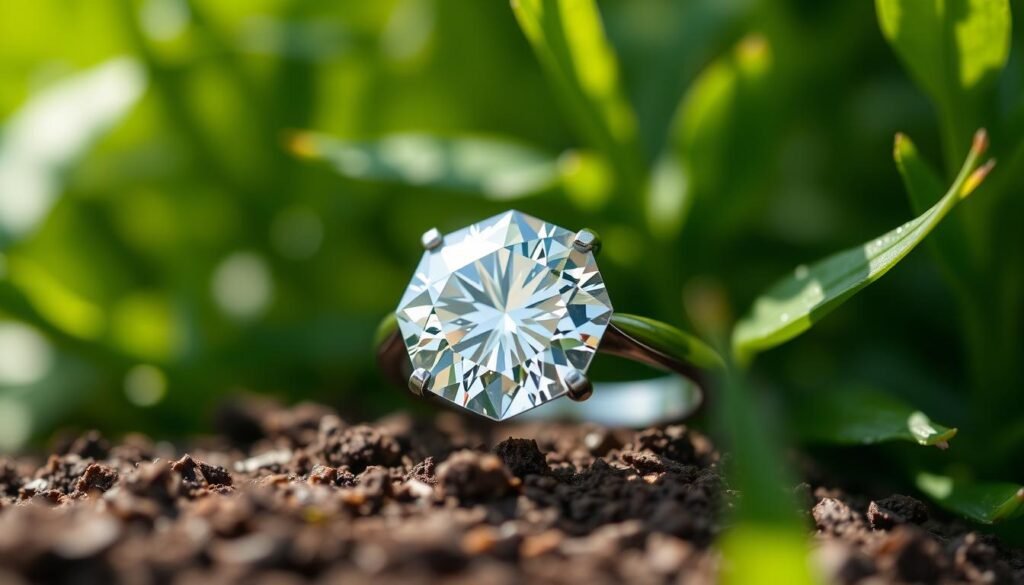
“The diamond industry is changing, with lab-grown diamonds becoming a greener option than mining. As people care more about the planet, this change will help make the industry better.”
Quality Assessment and Certification
When it comes to diamond jewelry, quality and certification are key. They ensure the diamond’s authenticity and value. The diamond industry has set up detailed grading and evaluation systems. These help buyers make smart choices, whether they choose natural or lab-created diamonds.
GIA Certification Process
The Gemological Institute of America (GIA) is the top name in diamond certification. The GIA checks a diamond’s diamond quality like cut, color, clarity, and carat weight, known as the 4Cs. This thorough check ensures diamonds are graded and certified accurately. It gives buyers a solid idea of the stone’s quality and worth.
Understanding Diamond Grades
- Cut Grade: Looks at a diamond’s facets’ precision and shape, affecting its sparkle and fire.
- Color Grade: Goes from D (colorless) to Z (light yellow), with higher grades being more valuable.
- Clarity Grade: Shows the diamond’s internal flaws, with fewer flaws meaning a higher grade.
- Carat Weight: Refers to the diamond’s size, with bigger stones usually costing more.
Authentication Methods
Buyers can also check a diamond’s diamond certification and authenticity through various methods. These include gemological tests, laser inscriptions, and detailed paper trails. These methods track the diamond’s origin and history.
| Authentication Method | Description |
|---|---|
| Gemological Testing | Advanced lab tests to check a diamond’s physical and chemical makeup |
| Laser Inscription | A unique ID number etched on the diamond’s girdle for tracking |
| Provenance Documentation | Papers that follow the diamond’s journey from origin to certification |
Knowing about quality assessment and certification helps buyers make smart choices. They can be sure they’re getting diamonds of the highest diamond quality and authenticity.
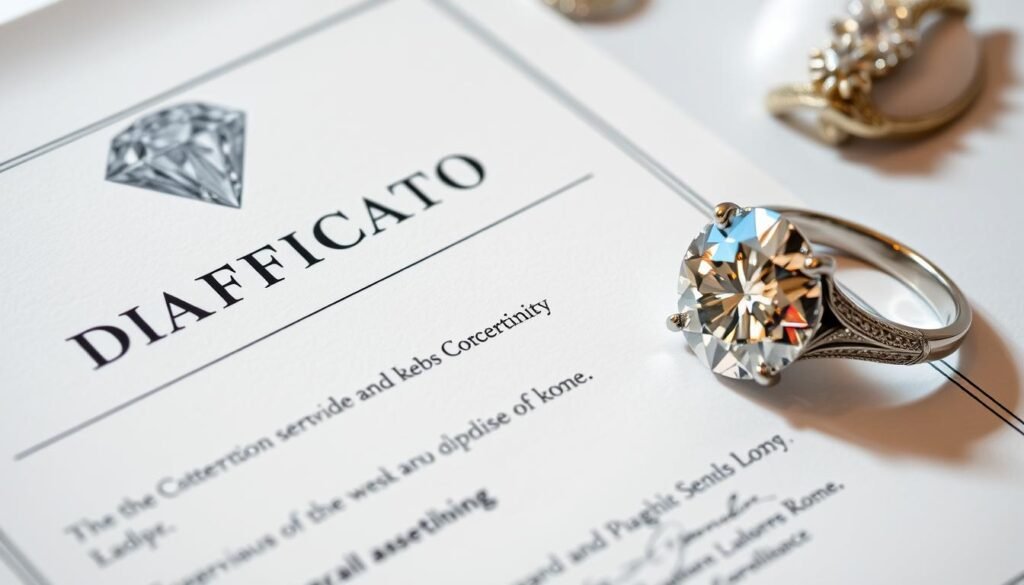
“Certification and authentication are essential for providing buyers with the confidence and peace of mind that they are purchasing a genuine, high-quality diamond.”
Aesthetic Differences and Visual Appeal
When choosing between natural and lab created diamond rings, beauty matters a lot. Both types have their own special qualities that make them stand out. These qualities add to their beauty and shine.
Natural diamonds, formed deep in the earth over billions of years, have a unique sparkle. Their internal structures and tiny imperfections create beautiful patterns. This natural beauty is what makes natural diamonds so sought after.
Lab created diamonds, made with advanced technology, can look very similar to natural ones. They can have perfect clarity and symmetry, shining brightly and consistently. Their flawless look appeals to those who want a diamond that’s precise and controlled.
In the end, the choice between natural and lab created diamonds depends on personal taste. Some love the unique look of natural diamonds. Others prefer the consistent beauty of lab-grown ones. Both options are beautiful, and the choice is up to the buyer’s taste.
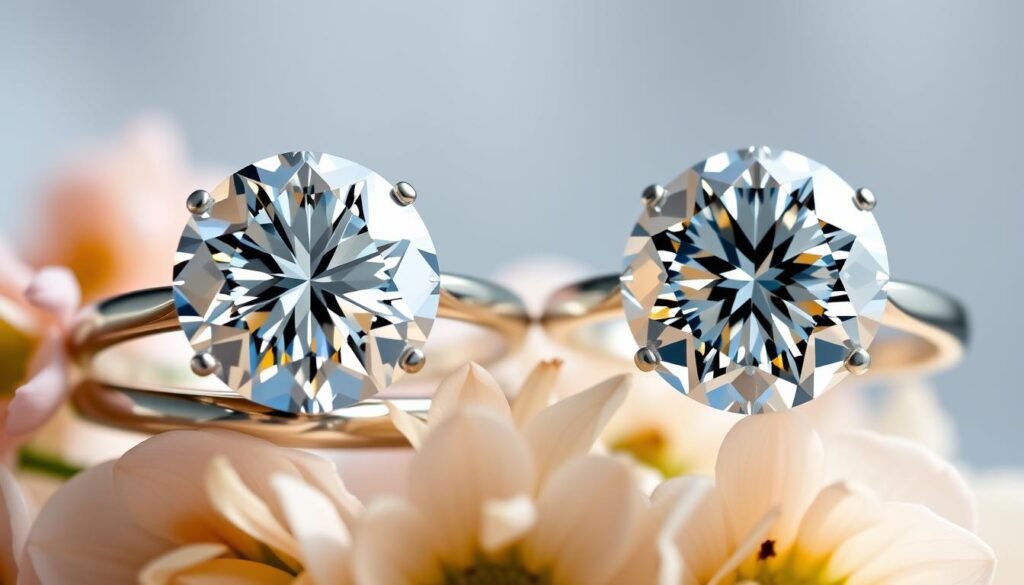
“The beauty of a diamond lies in the eye of the beholder. Both natural and lab created diamonds have the power to captivate and inspire.”
Ethical Considerations in Diamond Selection
Choosing an engagement ring involves more than just beauty. The diamond industry’s history is complex, with both good and bad effects on communities. It’s important for us to think about the social and environmental impact of our choices.
Mining Industry Practices
Traditional diamond mining has faced criticism for human rights issues, labor exploitation, and environmental harm. Ethical diamonds come from mines that focus on worker safety, fair pay, and eco-friendly methods.
Lab Diamond Production Ethics
Lab-grown diamonds offer a new option, being more sustainable and responsible. They’re made with technology, avoiding harmful mining and ensuring a clear production process.
Social Impact Comparison
- Mined diamonds: Potential for exploitation, environmental damage, and unequal wealth distribution
- Lab-grown diamonds: Less environmental harm, fair labor, and more economic fairness
| Ethical Consideration | Mined Diamonds | Lab-Grown Diamonds |
|---|---|---|
| Labor Practices | Potential for exploitation, unsafe working conditions | Transparent, fair labor practices |
| Environmental Impact | Significant environmental degradation | Reduced carbon footprint and energy consumption |
| Wealth Distribution | Unequal distribution, potential for conflict | More equitable economic opportunities |
Thinking about the ethics of our diamond choices helps us make better decisions. These choices can support a more sustainable and fair industry.
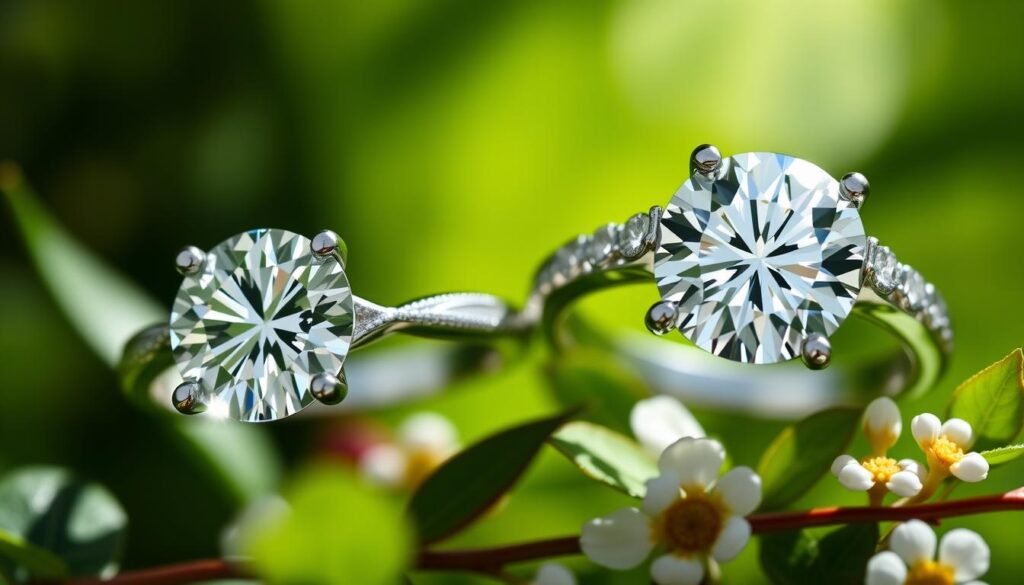
“The true value of a diamond lies not only in its physical beauty, but also in the positive impact it can have on the lives of those who create it.”
Market Value and Resale Potential
When looking at natural versus lab-created diamond rings, several factors come into play. Natural diamonds are rare and highly sought after, which makes them more expensive. Their value comes from their scarcity and long history in jewelry.
Lab-created diamonds, on the other hand, are made using advanced technology. They are more affordable but still offer the beauty of natural diamonds.
The resale value of natural diamonds is usually higher. They are seen as a traditional and valuable investment. This is because of their rarity and historical importance.
Lab-created diamonds, while valuable, might not increase in value as much. This is because they are more common and consumer views are changing.
Choosing between natural and lab-created diamonds depends on personal taste, budget, and investment goals. Knowing about diamond costs and resale potential helps buyers make a choice that fits their values and finances.

Hi, I’m Jimmy, the founder of Brilliant Jewelry Guide. With years of experience and a passion for timeless jewelry, I’m here to help you find pieces that tell your story and celebrate life’s special moments.
Disclaimer: This article contains affiliate links, which means we may earn a small commission if you purchase through them, without any additional cost to you. The content on this website was developed with assistance from AI.
